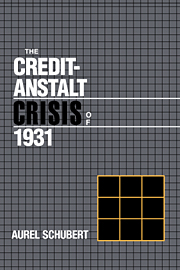Crossref Citations
This Book has been
cited by the following publications. This list is generated based on data provided by Crossref.
SCHNABEL, ISABEL
2004.
The German Twin Crisis of 1931.
The Journal of Economic History,
Vol. 64,
Issue. 3,
p.
822.
Klausinger, Hansjörg
2005.
‘Misguided monetary messages’: The Austrian case, 1931 – 34*.
The European Journal of the History of Economic Thought,
Vol. 12,
Issue. 1,
p.
25.
2015.
Austrian Banks in the Period of National Socialism.
p.
7.
Weigl, Andreas
2016.
Beggar-Thy-Neighbour vs. Danube Basin Strategy: Habsburg Economic Networks in Interwar Europe.
Religions,
Vol. 7,
Issue. 11,
p.
129.
Bertilorenzi, Marco
and
Telesca, Giuseppe
2016.
Contractual Knowledge.
p.
249.
AKBAŞ, Mustafa Emre
2017.
1800’lerin Küresel Krizleri, Büyük Depresyon ve 2008 Krizi.
İstanbul Gelişim Üniversitesi Sosyal Bilimler Dergisi,
Vol. 4,
Issue. 1,
p.
77.
Hautcœur, Pierre-Cyrille
2018.
Crise financière et dépression : peut-on tirer des leçons de la Grande Dépression ?.
Annales des Mines - Réalités industrielles,
Vol. Août 2018,
Issue. 3,
p.
7.
Resch, Andreas
2018.
Geschichte der österreichischen Privatbanken.
p.
81.
Aslanbeigui, Nahid
and
Oakes, Guy
2019.
The Ethics of Political Economy: Pigou in the Public Sphere.
OEconomia,
p.
237.
James, Harold
2020.
Making a Modern Central Bank.
2021.
Monetary War and Peace.
p.
281.
2021.
The Financial Crisis of 2008.
p.
408.
Wigmore, Barrie A.
2021.
The Financial Crisis of 2008.
Jánosi, Csongor
2024.
A Hungarian count’s business in Romania: the strange survival of
Tișița
(1907–40)
.
European Review of History: Revue européenne d'histoire,
Vol. 31,
Issue. 5,
p.
707.
2025.
Capital in Banking.
p.
209.



